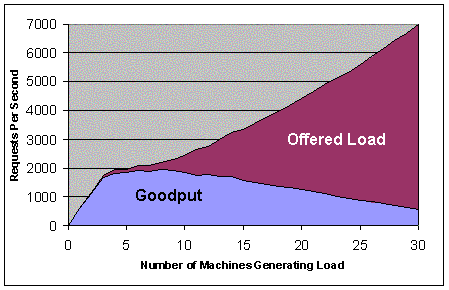
|

SSM protects its components from collapsing under overload. The use of AIMD and admission control allow SSM to protect itself. In particular, the maximum allowable pending non-acked requests that a stub can generate for a particular brick is regulated by the sending window size, which is additively increased on success and multiplicatively decreased on failure. This prevents the stubs from generating load that results in brick overload; each stub exerts backpressure [39] on its caller when the system is overloaded. In addition, bricks actively discard requests that have already timedout, in order to service only requests that have the potential of doing useful work.
SSM protects itself under overload. Part of the self-protecting aspect of SSM is demonstrated in the previous benchmark; SSM's goodput does not drop to zero under heavier load. In this benchmark, W is set to 3, WQ is set to 2, timeout is set to 60 ms, R is set to 1, and the size of state written is 8K.
SSM's use of the self-protecting features allows SSM to maintain a reasonable level of goodput under excess load. Figure 8 shows the steady state graph of load vs. goodput in the basic system without the self-protecting features. Figure 9 shows the steady state graph of load vs. goodput in SSM with the self-protecting features enabled. The x-axis on both graphs represents the number of load-generating machines; each machine runs 12 threads. The y-axis represents the number of requests. We start with the load generator running on a single machine, and monitor the goodput of SSM after it has reached steady state. Steady state is usually reached in the first few seconds, but we run each configuration for 2 minutes to verify that steady state behavior remains the same. We then repeat the experiment by increasing the number of machines used for load generation.
Comparison of the two graphs shows:
Note that in Figure 8 where goodput has dropped to zero, as we increase the number of machines generating load that the offer load increases only slightly, staying around 1500 failed requests per second. This is because each request must wait the full timeout value before returning to the user; the requests that are generated will arrive at the bricks, but will not be serviced in time. However, in Figure 9, the number of failed requests increases dramatically as we increase the number of machines. Recall that the load generator models hyperactive users that continually send read and write requests; each user is modeled by a thread. When one request returns, either successfully or unsuccessfully, the thread immediately generates another request. Because SSM is self-protecting, the stubs say ``no'' to requests right away; under overload, requests are rejected immediately. The nature of the load generator then causes another request to be generated, which is likely to be rejected as well. Hence the load generator continues to generate requests at a much higher rate than in Figure 8 because unfulfillable requests are immediately rejected.

|

|